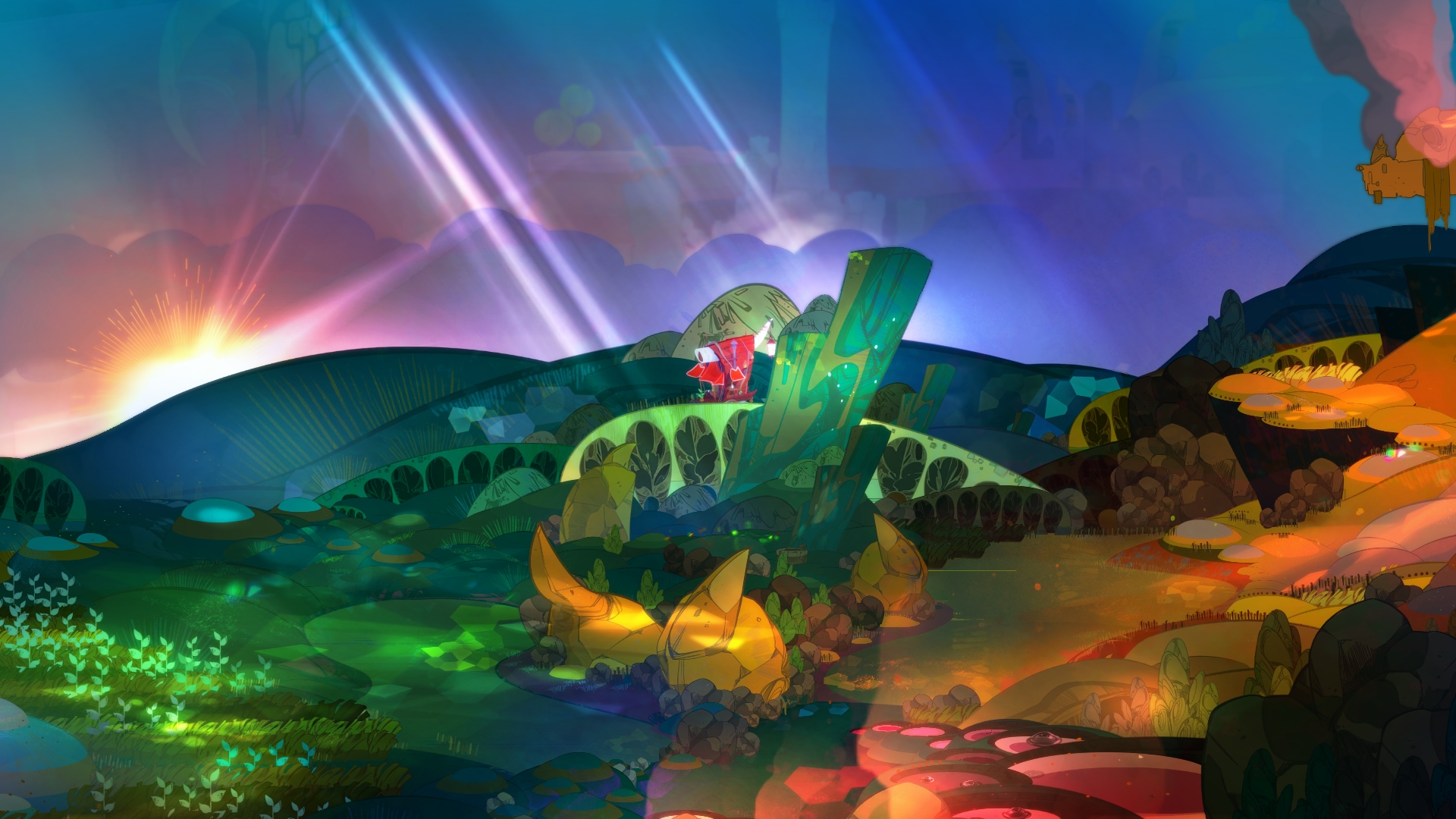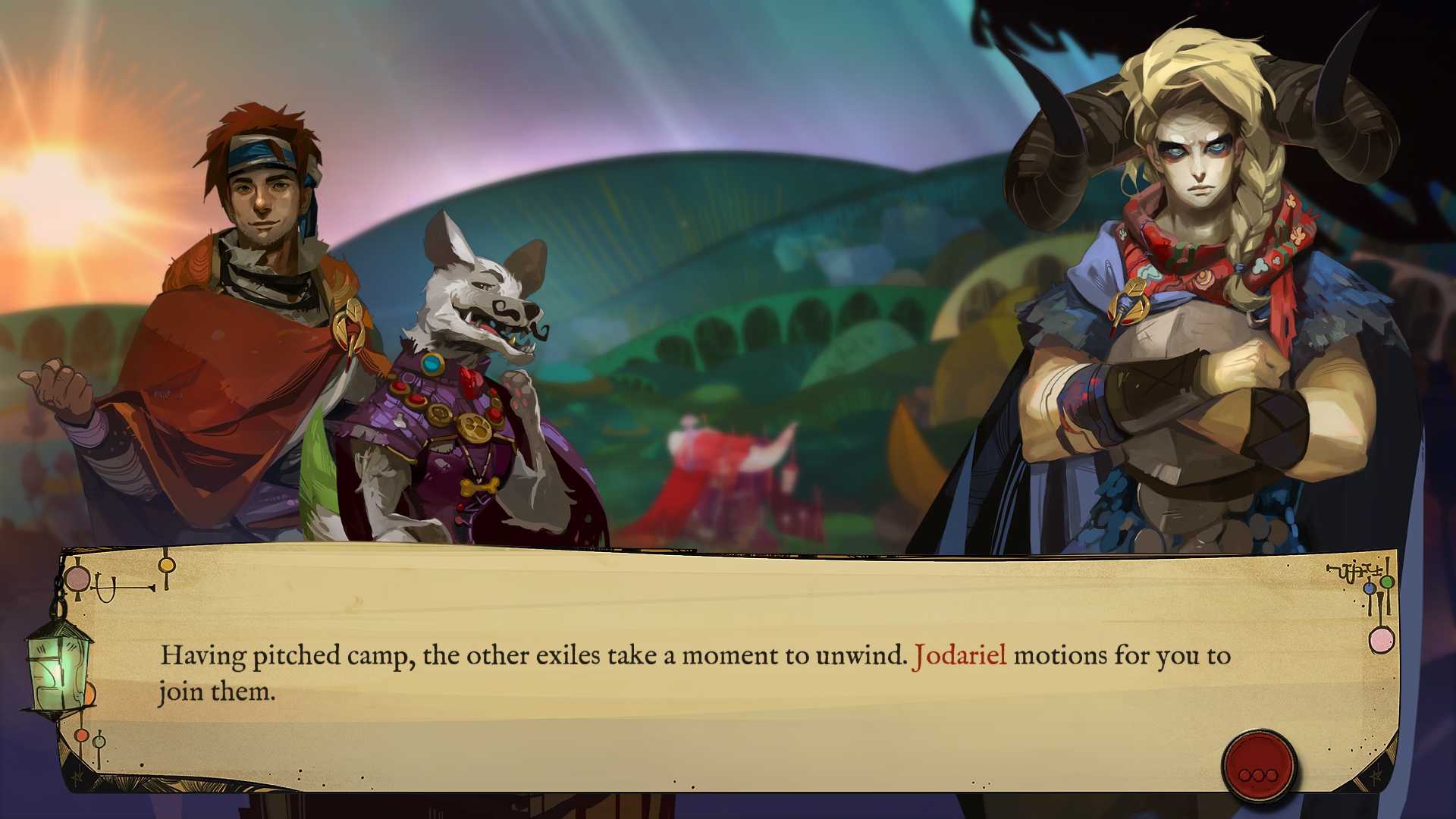
Supergiant Games is a force to reckon with in the industry. There are indie developers with more popular titles and probably those that are more “in” but Supergiant’s games arguably present some of the greatest heart, characterization, presentation and unorthodox gameplay out there. This was proven in Bastion and Transistor and the upcoming Pyre looks to take this in an even greater turn to left field. Imagine a tactical strategy RPG sports title presented in a visual novel style of story-telling with Wild West and high fantasy. Intrigued? GamingBolt spoke to the developer to learn even more about the genre-breaking title en route to its 2017 release.
"Having created two games now that heavily rely on the use of voiceover to deliver the narrative at the player’s pace, we were interested to see what we could do this time with a more-traditional storytelling technique: the written word."
After Transistor and Bastion, we don’t really know what we expecting with Pyre. What inspired the concept?
At Supergiant we feel like we’re in a unique position to be able to make original games. As a small independent studio, our games don’t have to sell 10 million copies or whatever to be successful for us, so we can make games that are more personal and specific. Yet, maybe it’s because of this approach that our first two games both found large audiences. This time around, after having worked on Transistor for about 2-and-a-half years, we once again wanted to make something new. We’re very grateful that fans of our previous games have been so receptive to new ideas from us, and we think the best way to continue to surprise them is to continue to surprise ourselves, by continuing to push ourselves creatively.
When we first started talking about what we wanted to do for our third project, we quickly became attracted to the idea of a game with an ensemble cast. We’ve really enjoyed creating the worlds and characters for our previous games, and wanted to come up with a context where we could do even more of this type of work. Many of the additional details flowed from there, and we found ourselves very intrigued by the premise of this large cast of characters trapped in a mystical purgatory, and them having to depend on one another to regain their freedom.
The characters continue the studio’s tradition of unique characterization. What can you tell us about their inspirations and design and how you managed to distinguish them from other games?
The appeal of making a game with a larger cast of characters was to have a world in which those characters could come in all different shapes and sizes. We want to show some of the wider boundaries of the characterizations early on with the first set of characters you meet, then push that even farther as the game progresses.
We develop our characters with an eye toward the fiction of the world itself. Where did these people come from? What was there upbringing? If they’re exiles now, who were they before, and how long have they been trapped? What are they contributing to the tone and mood of the story, and what’s their relationship to the player and to each other? We go about answering these types of questions, and then Jen Zee our art director visualizes them based on what we come up with.
We’ve made one fantasy world before in Bastion. That setting had a frontiersy sort of vibe, with its gravelly-voiced narrator and weapons that included various firearms and so on. Pyre‘s world feels older and more exotic by comparison, and is filled with mysticism and all sorts of sorcerous events. In some ways it’s a more traditional fantasy setting though I think we always end up putting our own twists on such traditions. In terms of inspirations, it’s always difficult to narrow this down since it’s so many different things. But when it comes to games, all of us can think of any number of ensemble-cast games that we’ve really enjoyed, including 16-bit classics like Shining Force and Final Fantasy VI, and more recent games as well.
What contributed to the dialogue system which allows players to learn more about different characters, terms and the impact of choices that one could make?
Having created two games now that heavily rely on the use of voiceover to deliver the narrative at the player’s pace, we were interested to see what we could do this time with a more-traditional storytelling technique: the written word.
As with our previous games, I think we have a certain perspective on this and a goal in using it that I hope will make it feel proprietary to what we’re doing. For example, in the world of Pyre, just having the ability to read makes you rather special — literacy has been outlawed in this world for many centuries, and the characters you meet need you and your ability to read to achieve their goals.
Early on we developed a tooltip system that provides context around key terms and characters at a glance. It may not sound like much but it got a really good response from what we showed of the game so far, as it helps get you oriented quickly in the world and means we can avoid writing contrived expository dialogue containing information that your character would know but you the player don’t. It also helps make the reading experience feel interactive, which is a goal of ours — we want there to be play and interactivity at every turn. Fans of our use of voice over needn’t worry either! There’s plenty of voiceover in this game, once again featuring the talents of Logan Cunningham, who voiced the main speaking characters in Bastion and Transistor. We’re once again using it to new effect here, though as ever, it’s hugely useful to setting the mood and atmosphere for the experience.
"Our high-level goal with the design of each of our games is creating layered depth beneath a simple set of mechanics."
With so much verbiage in the game, especially with the ability to learn more about lore, how does reading as a crime play into the central theme and story?
If we were going to deliver narrative through writing in this game, then we very much wanted the act of reading to feel significant in itself, and not to be taken for granted either by the player or by the characters in the world. That literacy has been outlawed in the world of this game tells you something about it, and makes the special book you find early on seem that much more valuable.
Your ability to read also initially defines your relationship with the first set of characters you meet. They know some very important information is contained in that book, so they know they can’t just coerce you into interpreting it for them, but need to make you feel welcome among them. You in turn get to speculate about just how sincere these characters are being. We thought this would set up a lot of interesting dynamics for the story, and help make the Rites — these mystic rituals central to the game — feel that much more deviant and unusual.
Without further ado, we have to ask about the combat system which combines sports with Transistor. How was the system developed and subsequently implemented?
Several factors figured into the design of the game’s action-packed rituals, which are at the heart of the experience.
First was this central theme of a group of characters having to depend on one another to achieve both a shared set of goals and their personal goals. Having the framework of a competition that requires characters to collaborate really served to reinforce the kind of experience we want to create here.
Second was the desire to make a game where the stakes were in a way even higher than life-and-death. In most games, death is just a brief setback — you die in battle, so you just try again until you don’t. In Pyre, we wanted the game to advance regardless of whether you won or lost. These characters are on a journey toward enlightenment, and enlightenment comes from failure not just from success. If the characters’ lives were at risk in every Rite, they would be learning nothing if they failed.
Third was having a context to define the rules of the game without any real-world constraints or conventions, so that we could make the most interesting and exciting gameplay we could come up with! Having this framework of a ritual competition means we can make the rules whatever we think makes for the best play experience, and have that make sense in the world of the game even if it doesn’t play exactly like other games. We think this also enhances the experience of discovering this secretive cosmic ritual — if it were overly familiar then it wouldn’t feel exotic.
What can you tell us about the different skills that characters can acquire and their impact on the plays they can perform?
Each different character has his or her own set of Masteries that can be unlocked as he or she gains enlightenment during the journey. You won’t be able to choose every Mastery for every character though you’ll be able to choose ones that accentuate a character’s natural strengths. For example, one of the first characters you meet is the demon Jodariel, who is very powerful, but rather slow. Each character can rush forward with a burst of speed, and in her case it’s this big surging charge that can bulldoze opposing characters, banishing them temporarily. It’s a useful move but you can’t use it very often, though one of the first Masteries Jodariel can unlock is the ability to perform this move twice in quick succession. This makes her much more maneuverable and powerful when defending.
Each character has eight different possible Masteries, plus different attribute scores that influence how effective they are in the Rites, as well as the ability to equip a special Talisman that augments his or her abilities further. All this combined with the ability to mix and match different characters we think will create a lot of variety during play.
Though it seems relatively simple, could you tell us about some of the more intriguing plays you’ve seen in Pyre? Are there any battles which will introduce more new mechanics to the ones we’ve already seen?
Our high-level goal with the design of each of our games is creating layered depth beneath a simple set of mechanics. We take inspiration from classic games that achieved depth while using fewer inputs, meaning you don’t have to memorize a ton of different buttons or commands, but the depth comes through the in the complexity of configurations and interactions that are available. We like for our gameplay to be open-ended enough to suit many different players’ instincts on how best to play.
"What constitutes a complete-feeling game varies based on a given game’s design, and I think given the goals of Pyre around its larger cast of characters, that it may end up being bigger than our previous games."
Right off the bat, by giving you access to characters of three very different speeds and movement styles, we let you decide whether you want to approach a given Rite through speed and reflexes or through a slow-and-steady approach, and we strive to keep these options well balanced. At PAX East we saw folks play through the Rites using a variety of different, viable strategies. Some players naturally lean toward relying on one or two characters at a time, while others are much more prone to teamwork. Some play very aggressively while others are more prone to dodging and outmaneuvering their adversaries. From our perspective, the more viable variety the better. The Rites will take place in a variety of locations against a variety of different adversaries. We’ve only shown the start of this so far and wanted to get players thinking about where else it could go.
What kind of side-quests can players expect and how will they play out given the game’s unique navigation and exploration?
We want players to have plenty of opportunity to get to know the characters in the game, and much of this will come from optional interactions and little side-quests that may come up from time to time. Your main objective at any given time in Pyre is to make it to the next Rite on time, but how you use the time you have is up to you, and we plan on presenting you with a lot of interesting options. On many occasions you’ll be able to make detours that may play into what certain characters want. Overall we want for players to feel invested in the characters they’re travelling with, and to be able to go deep both into their lives as well as the world around them. This mystical purgatory you’re exploring is a place with a lot of history and many different regions. We want there to be plenty of reasons to take the longer route to your destination.
Is there a particular play-length that Pyre will be aiming for?
We aim to make complete-feeling games that are paced well and are respectful of the player’s time. What constitutes a complete-feeling game varies based on a given game’s design, and I think given the goals of Pyre around its larger cast of characters, that it may end up being bigger than our previous games. We are way more concerned with the quality and pace of the experience than hitting some specific number of hours of play, though.
Are there any reasons why the game will be missing out on the X1?
We’re a small team of about a dozen people. It’s always been essential that we stay focused and not spread ourselves too thin. While it’d be nice to have our games available for every popular platform right at launch, this would either require us to scale back the ambitions of our games or staff up, and we don’t think either of those things is worth it right now. For our studio it’s worked out well to focus on just one or maybe two platforms at a time and make the best game possible, then see what opportunities there are after that, and we never rule anything out for the future.

















